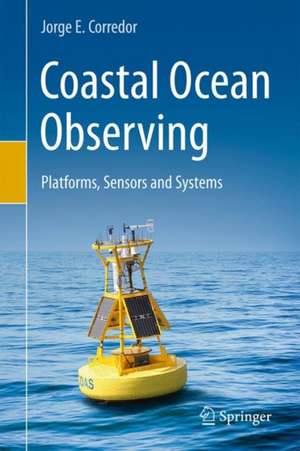Coastal Ocean Observing: Platforms, Sensors and Systems
Autor Jorge E. Corredoren Limba Engleză Hardback – 11 iun 2018
| Toate formatele și edițiile | Preț | Express |
|---|---|---|
| Paperback (1) | 578.05 lei 43-57 zile | |
| Springer International Publishing – 29 dec 2018 | 578.05 lei 43-57 zile | |
| Hardback (1) | 727.00 lei 43-57 zile | |
| Springer International Publishing – 11 iun 2018 | 727.00 lei 43-57 zile |
Preț: 727.00 lei
Preț vechi: 886.59 lei
-18% Nou
Puncte Express: 1091
Preț estimativ în valută:
139.11€ • 145.61$ • 115.78£
139.11€ • 145.61$ • 115.78£
Carte tipărită la comandă
Livrare economică 31 martie-14 aprilie
Preluare comenzi: 021 569.72.76
Specificații
ISBN-13: 9783319783512
ISBN-10: 3319783513
Pagini: 133
Ilustrații: XIV, 159 p. 34 illus. in color.
Dimensiuni: 155 x 235 x 16 mm
Greutate: 0.43 kg
Ediția:1st ed. 2018
Editura: Springer International Publishing
Colecția Springer
Locul publicării:Cham, Switzerland
ISBN-10: 3319783513
Pagini: 133
Ilustrații: XIV, 159 p. 34 illus. in color.
Dimensiuni: 155 x 235 x 16 mm
Greutate: 0.43 kg
Ediția:1st ed. 2018
Editura: Springer International Publishing
Colecția Springer
Locul publicării:Cham, Switzerland
Cuprins
Chapter1. Introduction. Chapter2. Electronic sensors and instruments for ocean observing. Chapter3. Coastal ocean observing platforms. Chapter4. Environmental constraints to instrumental coastal ocean observing. Chapter5. Data telemetry, command signaling and platform positioning in coastal ocean observing. Chapter6. Numerical models for operational coastal ocean observing. Chapter7. Coastal ocean observing data quality assurance, data quality control, data validation, data bases and data presentation. Chapter8. Planning, implementation and operation of coastal ocean observing systems.
Notă biografică
Jorge E. Corredor earned a M.Sc. degree in Biochemistry at the University of Wisconsin, Madison in 1972, and a Ph. D. in Oceanography at the University of Miami, Rosenstiel School of Marine and Atmospheric Science (RSMAS) in 1978. He served as professor in the Department of Marine Sciences at the University of Puerto Rico for a period of 38 years, holding the Chair of Chemical Oceanography. He served also as member of the Scientific Committee on Oceanic Research of the International Council for Science (ICSU), of the Ocean Studies Board of the US National Academies of Science, Engineering and Medicine, of the Board of Directors of the US Integrated Ocean Observing System (IOOS) Association and as Associate Director of the Caribbean Coastal Ocean Observing System.
Textul de pe ultima copertă
This manual describes the wide range of electromechanical, electrochemical and electro-optical transducers at the heart of current field-deployable ocean observing instruments. Their modes of operation, precision and accuracy are discussed in detail. Observing platforms ranging from the traditional to the most recently developed are described, as are the challenges of integrating instrument suits to individual platforms. Technical approaches are discussed to address environmental constraints on instrument and platform operation such as power sources, corrosion, biofouling and mechanical abrasion. Particular attention is also given to data generated by the networks of observing platforms that are typically integrated into value-added data visualization products, including numerical simulations or models. Readers will learn about acceptable data formats and representative model products. The last section of the book is devoted to the challenges of planning, deploying and maintaining coastal ocean observing systems. Readers will discover practical applications of ocean observations in diverse fields including natural resource conservation, commerce and recreation, safety and security, and climate change resiliency and adaptation. This volume will appeal to ocean engineers, oceanographers, commercial and recreational ocean data users, observing systems operators, and advanced undergraduate and graduate students in the field of ocean observing.
Caracteristici
Provides a thorough introduction to Integrated Coastal Ocean Observing Systems (ICOOS) Sheds new light on materials and devices that have made observation of several inaccessible variables possible Explains the functionality, practicality and challenges of using sensors
